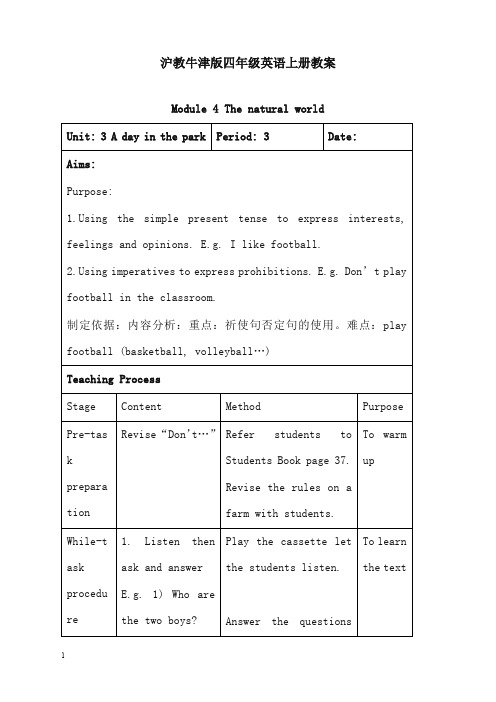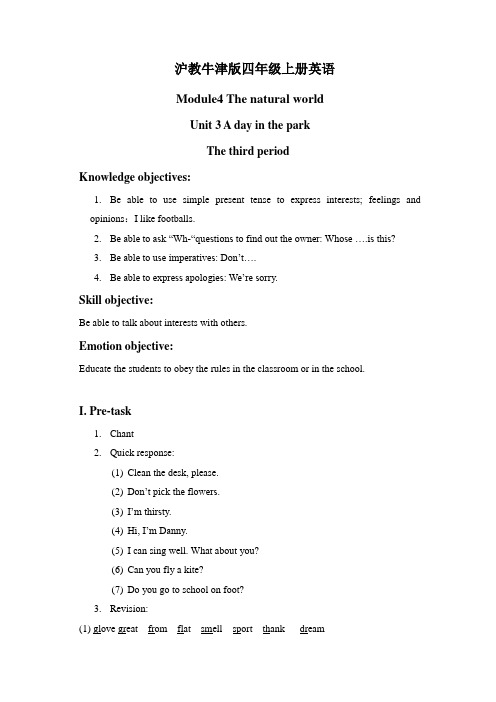沪教牛津版四年级英语上册Module4 unit3 A day in the park精品PPT教学
- 格式:ppt
- 大小:1.10 MB
- 文档页数:10


Module4 The natural worldUnit 3 A day in the parkThe first periodAims and demands:1。
Be able to master the words :mask, their.2.Be able to master the sentences:Whose…is it?Whose…。
are they? 3。
Be able to master the phonetics: sn, sl, swI. Pre-task1. Warming-up.Song or chant.2.Daily talk1) Quick response.What does your father do?Has he got a red shirt?How many shirts has he got?What does he like?What’s your mother?Does she like dogs?What has she got?2)Dialogue.a。
Show some pictures.T: I have got many pictures。
Please look and say according to thedialogue。
(bicycle, car, kite, skateboard, dress, shirt,bag…)—-- What does your father do? —-—He is a dentist。
—-— Has he got a shirt?———Yes。
-—-Is this his shirt?——-No, his shirt is red.-——Whose shirt is it? —--It’s my brother’s。
1.Revision.1)Say the plural nouns。
(上面的图片)2)Read and choose the correct words, then read it。

沪教牛津版四年级英语上册教案Module 4 Unit 3 A day in the park 第二课时1.教学内容(PERIOD CONTENTS)●Words: win, game, spinner, toothpickPatterns: Don’t…Materials: SB—P43,44, Cassette, WB—P31、32,G B--P37,382.教学目标(PERIOD TARGETS)●能知道如何做一个简易的陀螺。
●能说出每个标志的意思。
●能和同组的伙伴一起玩一玩这个游戏。
3.教学活动(PERIOD ACTIVITIES)1) 任务前期准备(PRE-TASK PREPARATION)根据不同的地点,复习学过的规则,并通过问答要求同学根据图片回答问题,以复习以前学过的一些问句。
Activity 1 Look and say●活动过程(Process)Activity 2 Guess●活动过程(Process)2)任务实施过程(WHILE-TASK PROCEDURE)A.新知识的引入(PRESETATION)利用游戏的图片,让学生学会简单介绍。
Activity 1 Look and learn●活动过程(Process)B.新知识的操练(PRACTICE)a) 机械性操练(MECHANICAL PRACTICE)模仿游戏中出现的标识以及游戏的规则。
Activity 1 Learn to say●活动过程(Process)Activity 2 Listen and write●活动过程(Process)b)意义性操练(MEANINGFUL PRACTICE)教会学生学会自己玩类似的游戏,并设计新的游戏和大家一起分享。
Activity 1 Learn to say●活动过程(Process)Activity 2 Listen and draw●活动过程(Process)3) 任务后期活动(POST-TASK ACTIVITY)让学生介绍一种自己喜欢的游戏或是自己设计的类似游戏。


沪教牛津版四年级上册英语Module4 The natural worldUnit 3 A day in the parkThe third periodKnowledge objectives:1.Be able to use simple present tense to express interests; feelings andopinions:I like footballs.2.Be able to ask “Wh-“questions to find out the owner: Whose ….is this?3.Be able to use imperatives: Don’t….4.Be able to express apologies: We’re sorry.Skill objective:Be able to talk about interests with others.Emotion objective:Educate the students to obey the rules in the classroom or in the school.I. Pre-task1.Chant2.Quick response:(1)Clean the desk, please.(2)Don’t pick the flowers.(3)I’m thirsty.(4)Hi, I’m Danny.(5)I can sing well. What about you?(6)Can you fly a kite?(7)Do you go to school on foot?3.Revision:(1) glove great from flat smell sport thank dream(2)Rewrite the sentences:Here’s a new football. (复数句子)Here ______ some new _______.Walk on the grass. (否定句)_____ _____ on the grass.We can climb the trees. (一般疑问句)_____ you _____ the trees?They’ve got a camera. (划线部分提问)_____ ______ they got?That is Kitty’s dress. (划线部分提问)______ ______ is that?II. While-task1.football(1) Guess: It is round ,It is big. It’s black and white. I can play it with my foot. What is it? (football foot+ball)(2) I like footballs . Do you like footballs?I can play football. Can you play football?2.What are these?(1) Show the things: basketball( basket +ball ); yo-yo; rope ; hoop; ping-pong …(2)Read after teacher: play_____;skip rope3.Danny and Peter are classmates. They have got a football. What are theytalking about? Listen to the tape.4.True of False:( ) Danny has got a new football.( ) Peter likes footballs.( ) Peter can’t play football.( ) They can play football in the classroom.5.Listen and follow the tape.6.Act out the dialogue.7.Make a new dialogue with other things. (yo-yo, rope, hoop and so on) III. Post-task1.Match the sentences:(1) Open the door. A. That’s all right.(2) Thank you very much. B. All right.(3) Give me a pen, please. C. That’s right.(4) I’m sorry. D. You’re welcome.(5) We can’t draw on the wall. E. OK. Here your are.2.Choose the best answer:( )(1) We like _______.A. footballB. footballsC. a football( )(2) Don’t play ______ in the classro om.A. footballB. footballsC. the football( )(3) I can play _______well.A. pianoB. pianosC. the piano( )(4) Don’t run. You can run ____ the playground.A. onB. inC. at( )(5) Here_____ some sugar and here_____ some sweets.A. are…areB. is…isC. is …are3.Rules for our classroom or for our school.Homework:1.Act out the dialogue or make a new dialogue.2.Write down at least 5 sentences, about rules for our classroom or for ourschool.。

沪教牛津版四年级上册英语Module4 The natural worldUnit 3 A day in the parkThe first periodAims and demands:1.Be able to master the words :mask, their.2.Be able to master the sentences: Whose…is it? Whose….are they?3.Be able to master the phonetics: sn, sl, swI. Pre-task1. Warming-up.Song or chant.2.Daily talk1) Quick response.What does your father do?Has he got a red shirt?How many shirts has he got?What does he like?What’s your mother?Does she like dogs?What has she got?2)Dialogue.a. Show some pictures.T: I have got many pictures. Please look and say according to the dialogue.(bicycle, car, kite, skateboard, dress, shirt, bag…) --- What does your father do? ---He is a dentist.--- Has he got a shirt? ---Yes.---Is this his shirt? ---No, his shirt is red.---Whose shirt is it? ---It’s my brother’s.1.R evision.1)S ay the plural nouns.(上面的图片)2)R ead and choose the correct words, then read it.---I have a good friend. (He; His ) name is Tom.----This is my mother. (She; He) is a nurse. (She, Her)hair is long.… (You; Your) are a pupil. (You; Your) brother is a fireman.---There are some (flys, flies)in the sky. (It, They)are white.---- (Who; Whose) bag is it? It’s (my; me) bag.II. While-task1.W hose…is it? It’s…1) (接着上面最后一题)T: This is your bag. (拿起自己的包)Look, whose bag is it? (It’s your bag.) (拿起学生的书)Whose book is it? (It’s xxx’s book..)2) Work in pairs. (Whose….is it? It’s…)3) Listen and repeat.(P42)4) Say and act.2. Whose…are these? They’re….1) Oh, I see two rubbers. Whose rubbers are these? They’re Peter’s rubbers. (repeat)2) Read the sentences.3) Ask and answer. (可提供图片,放一张头饰图片)Eg: Whose books are these? They’re her books.3. mask, their1)T: Oh, I see a mask. And I know it’s their mask.2) Read the words: mask, their.3) T: Whose mask is it? Ss: It’s their mask.4. Ask and answer. (提供关键词,有单数,有复数)dress ,my parrot; their shirts, your mask, his dogs, our bag, herslide, your swing, their1) Read the words.2) Ask and answer.Whose…is it? It’s… Whose… are these? They are….5.Learn the sounds.1)T: Oh, your slide and heir swing are beautiful. Look, some snakes are on the slide and the swing.2) Read the sentence.3) Repeat the words: snake slide swing4) Listen ,complete and read.snow sleep swim smith speak stealIII. Post-task1.Dialogue.Eg: ---Danny, is it your ball? ---No,it isn’t. My ball is red.---Whose ball is it? ---It’s Peter’s ball.---Peter, is it your ball? ---Yes, it is.---Here you are. --- Thank you.---That’s all right.1) Read the dialogue.2)Act out the dialogue.3) Make a new dialogue.Eg: xxx,are these your … No, my…are…Whose…are these? They are….2.C hange the sentences.1)This is a mask.(提问)2)It’s their car. (提问)3)My father is a policeman. (两种提问)4)It has a long stalk.(换种表达方式,意思不变)5)There are two flies on the table. (提问)Homework1.Listen and repeat.2.Dialogue.*************************************。
The Third Teaching PlanTeaching aims:Basic aims: ing imperatives to express prohibitions.e.g. Don’t play in the pond.2. Asking ‘How’ questions to find out the quantity.e.g. How many boys?3. Asking simple questions to obtain ‘yes/no’ responses.e.g. Do you like this game?Emotional aims: Using modelled phrases and sentences to communication with the teacher or other learners.Developing aim: Develop written texts by putting words in a logical order to make meaningful phrases or sentences.Key points: 1. Using imperatives to express prohibitions.e.g. Don’t play in the pond.2. Asking ‘How’ questions to find out the quantity.e.g. How many boys?3. Asking simple questions to obtain ‘yes/no’ responses.e.g. Do you like this game?Difficulty: Use modelled phrases and sentences to communicate with the teacher or other learners.Teaching aids: 1. Student’s Book 4A page 44.2. Cassette 4A and a cassette player.3. Photocopiable page 484. Toothpicks, scissors and glue.5. Drawing paper.Preparation: Make copies of Photocopiable page 48 for each students .Asking students to bring toothpicks, scissors and glue.The Fourth Teaching PlanTeaching aims:Basic aims: 1. Using the simple present tense to express interests feelings and opinions. E.g. I like footboot.2. Asking ‘Wh’-questions to find out various kinds of specific information about a person. E.g. Whose football is this?3. Using possessive adjectives to show possession.e.g. It’s my football.4. Using imperatives to express prohibitions.e.g. Danny , Peter, don’t play football in the classroom!5. Using daily expressions to express and respond to apologies.E.g. We’re sorry. That’s all right.Emotional aim: 1. Locate specific information in response to simple instructions or questions.Developing aim: I dentify key words in a structure by recognizing the stress.Key points: 1. Using the simple present tense to express interests, feelings and opinions. E.g. I like football.2. Using imperatives to express prohibitions.e.g. Danny , Peter , don’t play football in the classroom!3. Using daily expressions to express and respond to apologies.E.g. We’re sorry. That’s all right.Difficulty: Maintain an interaction by providing information.Teaching aids: 1. Student’s Book 4A page 45.2. Cassette 4A and a cassette play.。